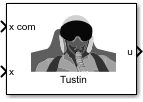Tustin Pilot Model
Represent Tustin pilot model
Libraries:
Aerospace Blockset /
Pilot Models
Description
The Tustin Pilot Model block represents the pilot model that A. Tustin describes in The Nature of the Operator’s Response in Manual Control, and its Implications for Controller Design [1]. When modeling human pilot models, use this block for the least accuracy, compared to that provided by the Crossover Pilot Model and Precision Pilot Model blocks. This block requires less input than those blocks, and provides better performance. However, the results might be less accurate.
This pilot model is a single input, single output (SISO) model that represents human behavior, and is based on the transfer function described in Algorithms.
This block has nonlinear behavior. If you want to linearize the block (for example, with the
linearize (Simulink Control Design) function or one of the
linmod functions), you might need to
change the Pade approximation order. The Tustin Pilot Model block implementation
incorporates the Transport Delay block with the
Pade order (for linearization) parameter set to
2 by default. To change this value, use the set_param function, for example:
set_param(gcb,'pade','3')
Note
The linmod function provides only basic linearization
capabilities. For full linearization functionality, use Simulink®
Control Design™ software. For more information, see Choose Linearization Tools (Simulink Control Design).
Ports
Input
Output
Parameters
Algorithms
This pilot model is a single input, single output (SISO) model that represents human behavior, based on the transfer function:
In this equation:
| Variable | Description |
|---|---|
| K p | Pilot gain. |
| T | Lead constant. |
| τ | Transport delay time caused by the pilot neuromuscular system. |
| u(s) | Input to the aircraft model and output to the pilot model. |
| e(s) | Error between the desired pilot value and the actual value. |
References
[1] Tustin, A., The Nature of the Operator’s Response in Manual Control, and its Implications for Controller Design. Convention on Automatic Regulators and Servo Mechanisms. May, 1947.
Extended Capabilities
Version History
Introduced in R2012b
